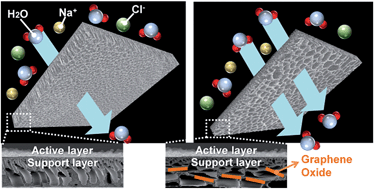A facile route to enhance the water flux of a thin-film composite reverse osmosis membrane: incorporating thickness-controlled graphene oxide into a highly porous support layer†
Abstract
In this study, we demonstrated that a reduction in solely the concentration of the polymer solution for preparation of the support layer effectively enhances the water flux of a thin-film composite (TFC) reverse osmosis (RO) membrane. However, a decrease in the polymer concentration caused the sub-surface structure of the support layer to become too porous, which unavoidably weakened the mechanical strength of the support layer. To overcome the problem, we prepared a highly porous support layer with improved mechanical strength by incorporating graphene oxide (GO) platelets. The thickness of the GO platelets was controlled by adjusting the mechanical energy input per volume of the precursor solution. We confirmed that well-exfoliated GO platelets (mean thickness: about 1.5 nm) are more effective in enhancing the mechanical properties of the support layer. The TFC RO membrane made of the GO composite support layer had almost 1.6 to 4 times higher water flux with comparable salt rejection compared to both the current upper bounds of the RO membranes prepared by modification of the active layer and commercial RO membranes.


 Please wait while we load your content...
Please wait while we load your content...